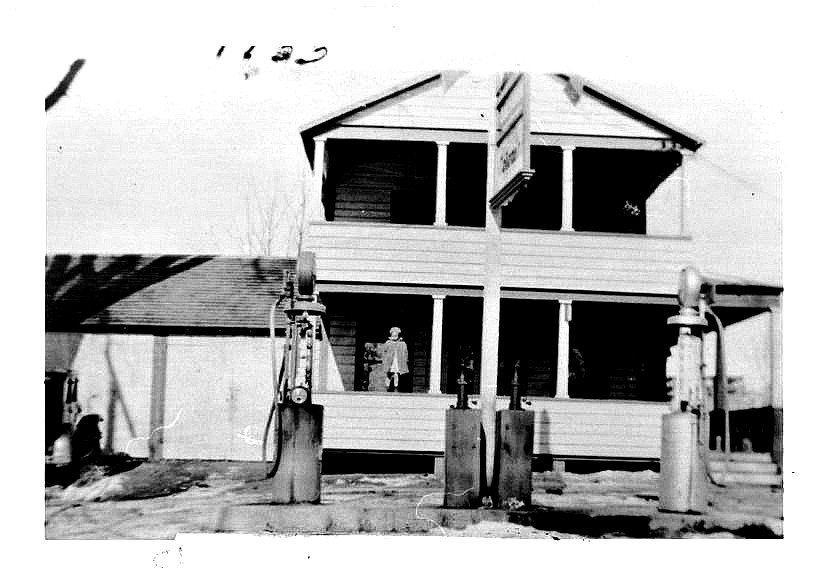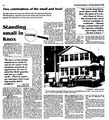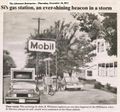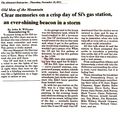Difference between revisions of "Stevens Gas Station of Knox, NY"
JElberfeld (talk | contribs) m |
|||
| Line 1: | Line 1: | ||
| + | [[File:BusinessLogo.jpg|74px|right|link=Businesses|Go to Businesses]] | ||
'''[[Stevens Gas Station]] of Knox, NY''' | '''[[Stevens Gas Station]] of Knox, NY''' | ||
Revision as of 01:35, 10 October 2012
Stevens Gas Station of Knox, NY
Buggies to Buicks: 70 years of service at Stevens' gas station
The Helderberg Sun, Tuesday, March 4, 1975
Knox Notes - Helen Munroe
The building now known as “Stevens Gas Station" has served public transportation for better than 70 years. First as a blacksmith and wagon shop. Then, since May 6, 1931, as a gas station.
Daniel Webster (Web) Stevens and his wife Edna first opened for business with hand crank pumps, and homemade ice cream.
Margaret (Cy) Stevens, who now runs the business, told me her father purchased the building from some people named Baxter, on March 4, 1929. In the Iess harried days of the 1700's and 1800's, it was not felt necessary to record a deed, so the Baxters owned the building for 30 years. It is not known exactly how old the building is, but it is believed it is one of the first buildings in Knox.
Knox was separated from Berne on Feb. 28, 1822 and received its name from Colonel Knox of Revolutionary fame.
When Web bought the building, the ground floor still contained the blacksmith shop, so the upstairs apartment was rented fn Louis Briggs, while the ground floor was converted to an ice cream parlor and kitchen. Although modernized today, the original beams have been retained. As I sat at Cy's kitchen table looking at those beautiful old beams, I wondered what kind of tales they would tell if able to speak. It gives you a feeling of awe to think that you may be sitting in the very spot where some great historical event took place.
Edna sold candy and cigarettes and made ice cream from cream and eggs purchased from the Sheridon Sadlemire farm on Street Road, now owned by Fred Fortuin. And Web froze the ice cream in a hand crank freezer using ice from an ice house located on the John Bogardus farm, now owned by Aldo DiCamillo.
Once they got the business going, the Stevenses moved from their home next to the school, which is now the fire house, believed to have been owned by Dave Honour and now owned by Roger Van Wormer.
Cy and sister Virginia were just little girls at that time, so Cy has seen many changes over the years. For example, in those days, kerosene sold for 6 cents per gallon and gas sold for about 10 cents per gallon.
Today, Cy’s gas is delivered to her by her brother Marshall, who runs a very successful fuel business. Brother Ray runs a trucking business. The Stevens, like the Saddlemires, Quays, and many others, are long time residents of Knox, they have played a large part in the history of the town, and continue to do so today. Ina book, “Landmarks of Albany County” loaned to me by Cy, written by Amasa J. Parker of Albany, in 1897, the portion about the history of Knox contain many familiar names… Witter, Barkley, Keenholtz, Galllup, VanAuken, Schoonmaker, Gage, Chesebro, Haverly, Frink and Quay. These people, and thousands of others like them, and the individuals who have made America what it is today, the “Land of the Free and the Home of the Brave.”
Stevens' Gas Station - Sept. 6, 1990 - Altamont Enterprise Stevens' Gas Station - Drawing by Amy Pokorny - Available at the Octagon Barn Clear memories on a crisp day of Si's gas station, an ever-shining beacon in a storm - Altamont Enterprise - Thursday, November 10, 2011 Clear memories on a crisp day of Si's gas station, an ever-shining beacon in a storm - Altamont Enterprise - Thursday, November 10, 2011
Standing Small in Knox – Stevens’ Gas Station
Altamont Enterprise, Thursday, September 6, 1990
Two celebrations of the small and local
We often equate the large and official with the important.But here The Enterprise' celebrates the virtues of the small and less official, against the officialdoms of business and government.
Mobil Oil Corporation now requires look-alike, lit-up canopies and signs for its gas stations across the country. But Margaret Stevens — who has pumped Mobil gas for 36 years from her station on Route 156 in Knox—isn't going to comply. "I can't afford it. It's too much money for me," she said. As a consequence, starting Sept. 1, Stevens can no longer accept Mobil credit cards from her customers, and can no longer advertise that she sells Mobil gas.
Slice of America
The Mobil station in Knox looks like a picture from our past — small-town America at its best. It's located on the main street in town, Route 156, about half way between the fire house and the country store. A few gas pumps sit out front of a white clapboard building. Green striped awnings hang over the glassed-in front porch, where neighbors pause to greet each other and exchange news. Ice cream and sodas are for sale in the front room where old-fashioned wooden tables and benches await customers.
Church bells can be heard ringing from across the street, mingled with the bell that indicates a customer has pulled in for gas. Margaret Stevens is ready to answer the call. Although she has just turned 64, she moves with the energy and purpose usually reserved for 12-year-old kids dogging fly balls. The customer, a shirtless young man, who got $10 worth of gas, says he'll be by later on in the afternoon to pay. Stevens doesn't bat an eye. "Yah," she says matter-of-factly, "he will." She knows her customers well, and the trust is mutual. She's been serving them for generations. Her father, Daniel Webster Stevens (known - to friends and neighbors simply as "Web" bought a dilapidated old black' smith shop at the site in 1929. On May 6,1931,- he opened for business selling Esso gasoline. In 1954, the Stevenses started selling Mobil gas. When Webster died 20 years ago, his daughter took over the business and has been running it ever since.
Most of her business comes from selling gasoline. She's outside in all kinds of. weather, waiting on her customer. "It doesn't bother me," she said. "I bundle up." She works long hours, seven days a week. Weekdays, she opens at 6 a.m., and closes at 10 p.m. She shortens her usual 16-hour workdays on weekends. Saturdays she doesn't open until 6:30 a.m., and Sundays she opens at 7:30 a.m.; she stays open until 10 p.m. weekends, too. Stevens shrugs, unimpressed with her rigorous schedule, and simply calls it "farmer's hours."
"It's my living," she says, and adds, "It keeps me healthy." She lives in the house with the store front that faces the pumps and says that when she needs to leave, to do some shopping, for example, someone will mind the store for her. "I've got a lot of good relations," said Stevens.
One of them, she says, is her brother Marshall Stevens, who runs the Mobil fuel oil business in Knox. "My brother waits on me." said Stevens, explaining that every day one of his trucks will come to fill her small tanks, which hold only 550 gallons, with Mobil gasoline.
That's why she said she'll stick with Mobil, even though they now won't let her advertise their product or accept their credit cards. "Their policy is to have all their stations look alike, with a canopy, new lights, and a lit-up sign," explained Stevens. They want company stations. They don't want the little guy."
Don Turk, a Mobil spokesman from Dallas, said the requirements are part of a nationwide trend of "uniform marketing. '"We want, to make our stations easily recognizable," he said. "This will assure customers passing by they can stop and get a good quality, product at an affordable price."
He said that the required canopy and lighting would allow for "easy and convenient access... safe flow through of traffic... protect the customer from the weather." "We have certain design standards we abide by," said Turk "and we do require some minimum standards of appearance (be met) to advertise Mobil gasoline and use our credit cards... That's to assure our customers they're getting quality Mobil products."
Turk said that most Mobil gasoline is sold though franchise dealers. "They make up 70 percent of our business," he said. Their gasoline is delivered by the company, rather than individually, and the company has a real estate investment in the franchise dealership. Stevens says the bad weather never bothers her customers, because she pumps the gas for them And she doesn't think she'd like the looks of a big modern canopy in her front yard, even if she could afford it.
Stevens anticipates the new restrictions may hurt her business some, but notes she can still accept Visa and Mastercard. She said, "Some salesmen that have to use a company card, they won't stop," But she thinks her regular customers will stick by her. "They're mad," she said. "They can't believe they could do this to me."
Stevens says she plans to continue her business as she always has. "I have no choice," she said. "They're not going to put me under." Stevens concluded,"As long as the Lord gives me my health, I'll be here."
Si Stevens keeps on pumpin': Margaret Stevens pumped Mobil gas last week —just at the has for 36 years — from her quaint station on Route 156 in Knox.
A matter of image
Tiny gas station stalls at being forced into '90s
By-Brad Kelly Staff writer
KNOX — Mobil Oil Corp. wants to push Margaret Stevens into the 1990s, but the 64-year-old town native isn't budging.
For years, Stevens has pumped Mobil gas from a trio of tanks that stand outside her white two-story house on winding Route 156. Inside, she sells ice cream, candy, cigarettes and chewing tobacco from behind a counter that faces her cluttered but cozy living room.
Stevens' place is not your modern station with white canopies, sleek gas pumps and brightly lit signs and she likes it that way.
But recently, Stevens learned she has until 1992 to modernize the station.
Her business, she was told, does not meet minimum appearance standards established by Mobil. Those standards require all stations to install canopies and pumps that offer at least three grades of gasoline.
Stevens said she isn't about to comply. As a result, she cannot advertise the gas she sells after 1992 and will no longer be able to accept Mobil credit cards.
"They want me to change it and I'm fighting it," said Stevens, who took over the business from her father, Daniel, 20 years ago. "We don't mean nothing to them, the little guy. They want us right off the map."
Stevens said she plans to replace the Mobil sign with one that bears the family name. While the name change is not likely to drive away those who know what gas Stevens sells, it might keep strangers away.
Of course it's going to-hurt some," she said.
Mobil's guidelines were established in 1985 to keep the company competitive and to provide a "consistent image," according to spokeswoman Ida Walker.
"It's a national, coast-to-coast image improvement program," she said.
Walker said she sympathizes with Stevens. but there are no exceptions to the rule.
"There isn't an exception possible here because all other (stations) are required to come up with these minimum standards," she said. "This is not intended to hurt any one individual."
Walker said Mobil went to great lengths to find a new distributor for Stevens when it became apparent that her current dealer could not meet a company requirement that distributors sell more than 600,000 gallons of gas each year,
Mobil will not renew its contract with Stevens distributor, who also happens to be her brother Marshall, because he sells fewer than 600,000 gallons a year, Walker said.
"We have worked out a way that this individual can still have gasoline to service customers, but the guidelines indicate (stations) can't sell that product under our flag unless they do meet 'certain standards." she said.
But Stevens, who advertises only once a year, in the Berne-Knox-Westerlo High School yearbook, said she can't afford to make the changes. Never married, Stevens said she works 16 hours a day. seven days a week to stay competitive in an area where only several thousand people live.
"They don't put in the hours I put in." she laid of her competition. "Of course I live here. That makes the difference.
Opened in 1931 by her father Daniel, the business is one of only a few Ma and Pa service stations left in the area, according to Stevens. The place was a blacksmith shop before her dad bought it, she said.
Stevens, a short woman with thick glasses and a staccato laugh, can remember when her father had to pump gas with a crank.
"When we started here there was no electricity," she said. "You had to pump by hand."
Ice cream was also made by hand, according to Stevens.
Today, the pumps are electric and the ice cream is packaged. But Stevens still personally attends to each customer announced by a loud bell that reverberates through the house each time a vehicle pulls in. Asked whether she ever thought about another line of work Stevens replied, "Nope. It beats going to the city every day."
Albany Times Union - Sunday, September 16, 1990
Old Men of the Mountain
Clear memories on a crisp day of Si's gas station, an ever-shining beacon in a storm
By John R. Williams
Remembering Si
To anyone living on the Hill (especially the OFs), there was an individual who was a fixture in town that many remember and were telling their own stories about. This person is really missed.
She was Margaret (Si) Stevens who ran the Mobil station in the town of Knox. Many of the OFs wish she was still there. One OF said that it was such a relief to see the lights of her gas station shinning on the sign at night when they were on the road in a blinding snowstorm. It was like a lighthouse on a foggy night to sailors at sea.
In the garage next to the house was the kerosene tank, which Si hand-cranked to fill a kerosene can. One OF mentioned how she would watch the dial on this tank and, when it got to five gallons, she would stop cranking and you wouldn't get a penny over. When the OF got his five gallons of kerosene, he got his five gallons to the 1/100.
The OFs were also remembering how they aged but Si didn't.
Off the Hill, time marched on — serve-yourself stations, computerized pumps, modern islands with canopies, fast-food stores attached to the stations, and no attendants, just clerks inside the store who didn't know gasoline from bottled water. Si, with her gas station on the Hill, was in a time warp. One OF said it was like a Rockwell painting. In the evening, locals and relatives sitting on the porch would eat ice cream, telling tales of the day — normally known as passing news or gossiping is more like it one OF said. One OF mentioned that the station never seemed to close and Si was always there. The OFs started trying to remember when she took time off, or even left on a vacation and none could remember.
All this talk about Si and the station in Knox prompted this scribe to introduce a painting this scribe did of Si and her station to show this was a real place, and a real person.
From cosmopolitan Albany and Schenectady, a short ride into the Hilltowns surrounding the cities is truly rural America, but it is fading fast.
Those attending the breakfast at the Duanesburg Diner, in Duanesburg and many contributing their tales of Si were: Roger Chapman, Roger Shafer, Robie Osterman, Steve Kelly, Mace Porter, Gary Porter, Jack Norray, Mark Traver, Glenn Patterson, Miner Stevens, Arnold Geraldsen, Don Moser, Jim Rissacher, Mike Willsey, Harold Grippen, Gerry Chartier, Willard Osterhout, and me.
- The Altamont Enterprise - Thursday, November 10, 2011













